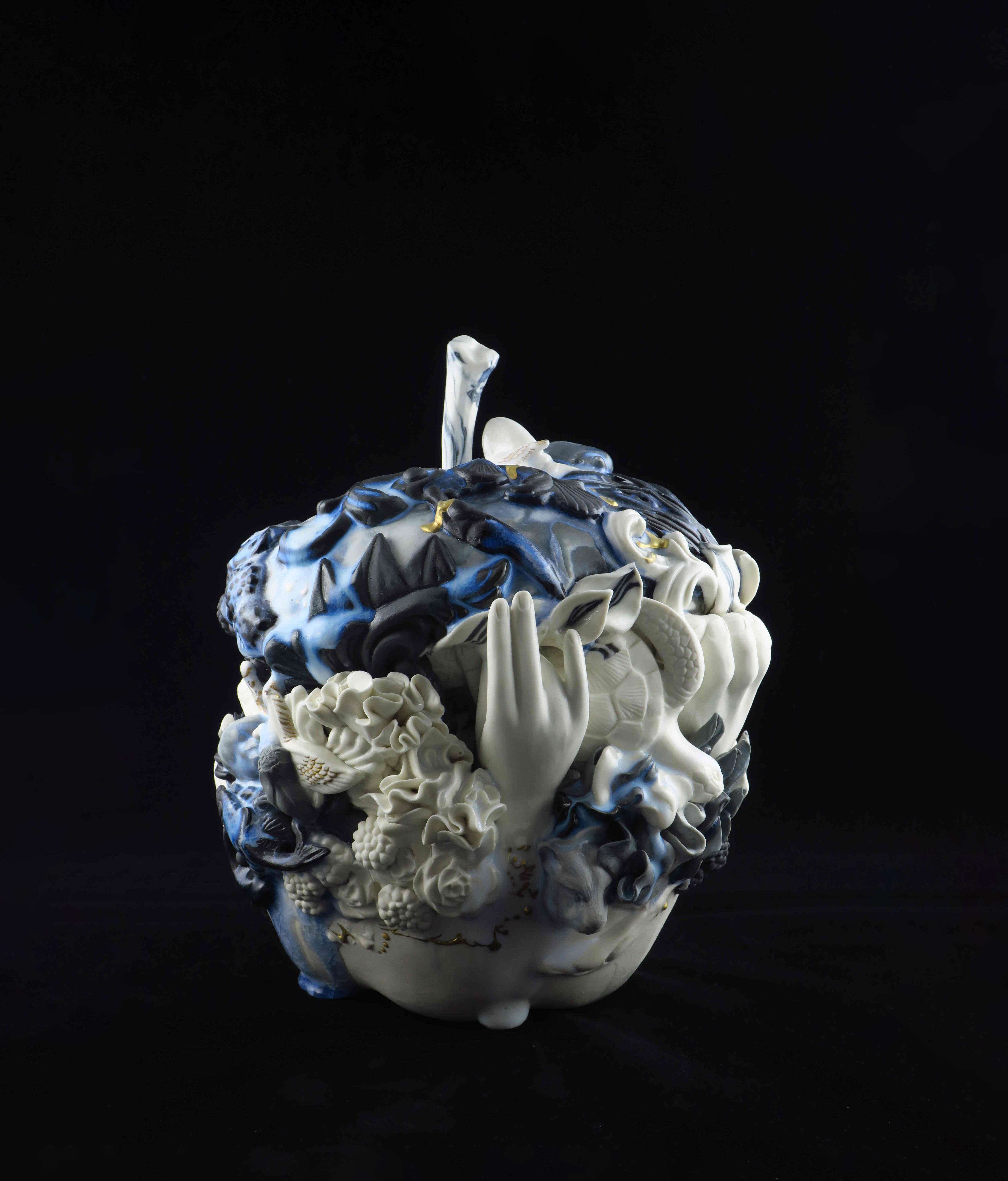
C L A Y I N M O T I O N W O M E N A R T I S T S I N C O N T E M P O R A R Y J A P A N E S E C E R A M I C S D A I I C H I A R T S , L T D .

Dai Ichi Arts, Ltd. is a fine art gallery that is exclusively devoted to showcasing Modern ceramic works of art from Japan.

Since our beginning in 1989, we have been focused on highlighting important Japanese ceramics to the contemporary art scene in New York City. The gallery has introduced pieces to the permanent collections of several major museums including The Metropolitan Museum of Art, The Art Institute of Chicago, Minneapolis Institute of Art, Indianapolis Art Museum, The Princeton University Art Museum, and many more.
We are committed to providing bespoke and leading expertise to collectors, liaising with artists, and showcasing inspiring exhibitions and artworks. We welcome you to contact us for more details.
Clay in Motion: Women Artists in Contemporary Japanese Ceramics Exhibition catalog
July 20 – August 18th, 2023
18 East 64th Street, Ste. 1F
New York, NY, 10065, USA
www.daiichiarts.com
I N T R O D U C T I O N
Dai Ichi Arts is delighted to present the summer exhibition “Clay in Motion: Women Artists in Japanese Ceramics”. This group spotlights the works of several distinguished contemporary women artists. From emerging artists to artists who are part of a vanguard generation of highly influential post-war artists in Japan, the works presented in this exhibition are imbued with intelligence, creativity, and sensitivity for form The title “Clay in Motion” points to the forward-facing contemporary ceramic industry that is moved by innovation and inclusion
In Japan, women had historically previously only been able to work in supporting capacities within the ceramic industry, up until the 20th century. The idea of an individual artist as a professional category was further complicated by the assimilation of the anonymous craftsman by way of the Mingei movement: the notion of individualistic authorship behind a ceramic work was not widespread practice until relatively recently It was only after the Second World War that the ceramic industry saw a robust growth in female potters who were artists in their own right The 1960s experienced an increase in the number of women potters who practiced in their own studios and who had founded their own kilns in Japan. From then, the influence of women in the field of Japanese contemporary ceramics grew exponentially.
The idea that the definition of an artwork encompasses any perceptible body of fired clay permeated the Japanese pottery industry in the mid-twentieth century The pioneering artist Yagi Kazuo had observed that pottery had evolved from something utilitarian- to be handled, touched, and used in quotidian life- to a perceptible object to be seen. This isolation of the optical quality of ceramic objects was canonized in the 1950s with the genre “Obuje-Yaki オブジェ焼” (the Kiln-Fired Object), in reference to the “Objet d'art”. Women potters in Japan are at the forefront of this sculptural ceramic category in Japan in the 21st century.
Thus, we see artists such as Tashima Etsuko and Ayumi Shigemastu pushing the boundaries of sculptural clay, exploring concepts such as tactility and materiality while honoring traditional Japanese ceramic traditions Matsuda Yuriko and Oishi Sayaka explore ceramic surfaces and how decoration may convey memory, emotion, and more. On the other hand, artists such as Watanabe Aiko, Ogawa Machiko and Kitamura Junko explore the functional vessel and its potential for craft expression.
We warmly invite you this summer to explore the range of ceramic art that women artists produce in the field of Japanese contemporary ceramics.

S H I G E M A T S U A Y U M I
Ayumi Shigematsu (b 1958) is part of the vanguard generation of highly influential postwar female artists in Japan whose practices are inspired by concepts of female sexuality She studied with Suzuki Osamu (1926-2001) at the Kyoto University of Arts and as pioneer for women in a historically male-dominated pottery industry in Japan, she went on to work as one of few female professors teaching ceramic practice at her alma mater. Having studied with the pioneer of the Sodeisha ceramic movement, her propensity for sculptural rather than functional clay forms reflect key Sodeisha tenets. While Shigematsu’s sculptural forms and artistic process are informed by these core philosophies, she also draws influence from the 1970s, a period of consolidation of many art movements
Shigematsu’s relationship with the clay medium is exceptionally organic: her artistic process follows the tenet that the ceramic form is “found” through its making; she uses weight and gravity of wet clay to guide her hand as she builds the form without any prior planning Her process of making brings attention to the materiality of ceramics and highlights the tactile quality of ceramic production via a meditative, sculpting process involving clay coiling, hand-pinching, and other non-wheel thrown techniques. Her glazes are also intentional and unconventional. She uses a pale, pastel color palette in her sculptures, which goes against an aesthetic convention in Japanese pottery that works of art in clay should reflect the visual properties that clay provides. In other words, she rebels against the notion that “clay should only look like clay.” Shigematsu has indeed emerged as a radical artist who has established a unique and influential artistic practice
重 松 あ ゆ み

 Shigematsu Ayumi 重松 あゆみ (b. 1958) Yellow Jomon, 2018
Stoneware
(h) 12.7" x (w) 11.0" x (d) 10.4"
Shigematsu Ayumi 重松 あゆみ (b. 1958) Yellow Jomon, 2018
Stoneware
(h) 12.7" x (w) 11.0" x (d) 10.4"

 Shigematsu Ayumi 重松 あゆみ (b. 1958)
Jomon Spiral, 2015
Stoneware
(h) 14.5" x (w) 12.5" x (d) 13.9"
Shigematsu Ayumi 重松 あゆみ (b. 1958)
Jomon Spiral, 2015
Stoneware
(h) 14.5" x (w) 12.5" x (d) 13.9"

Vertiginous, geometric, and sculptural are words ascribed to Kitamura Junko’s style. Trained under the important Sodeisha pioneer Suzuki Osamu, Kitamura’s sense for abstract, sculptural form shines through in her functional vessels. She also studied under the Living National Treasure, Kondō Yutaka (1932-1983), whose sense for surface pattern is palpable in her work. Her intricate patterns are inspired by Korean Buncheong pottery, which reached its zenith in popularity during the Joseon dynasty
Her work, like Buncheong pottery, features concentric, dotted, impressed surface design inlaid with a viscous white slip. At the same time, it recalls the extensive history of decorative arts in Japan, taking after textile patterns in the intricacy of the linear designs made in a scrolling pattern across the surface of her monochromatic clay. As a woman in the male-dominated ceramic industry in Japan, Kitamura progresses the field forward.
北 村 純 ⼦ K
I T A M U R A J U N K O

 Kitamura Junko 北村 純子 (b. 1956) Vessel, 2022
With Signed Wood Box; Stoneware (h) 13” x (diameter) 11.5”
Kitamura Junko 北村 純子 (b. 1956) Vessel, 2022
With Signed Wood Box; Stoneware (h) 13” x (diameter) 11.5”
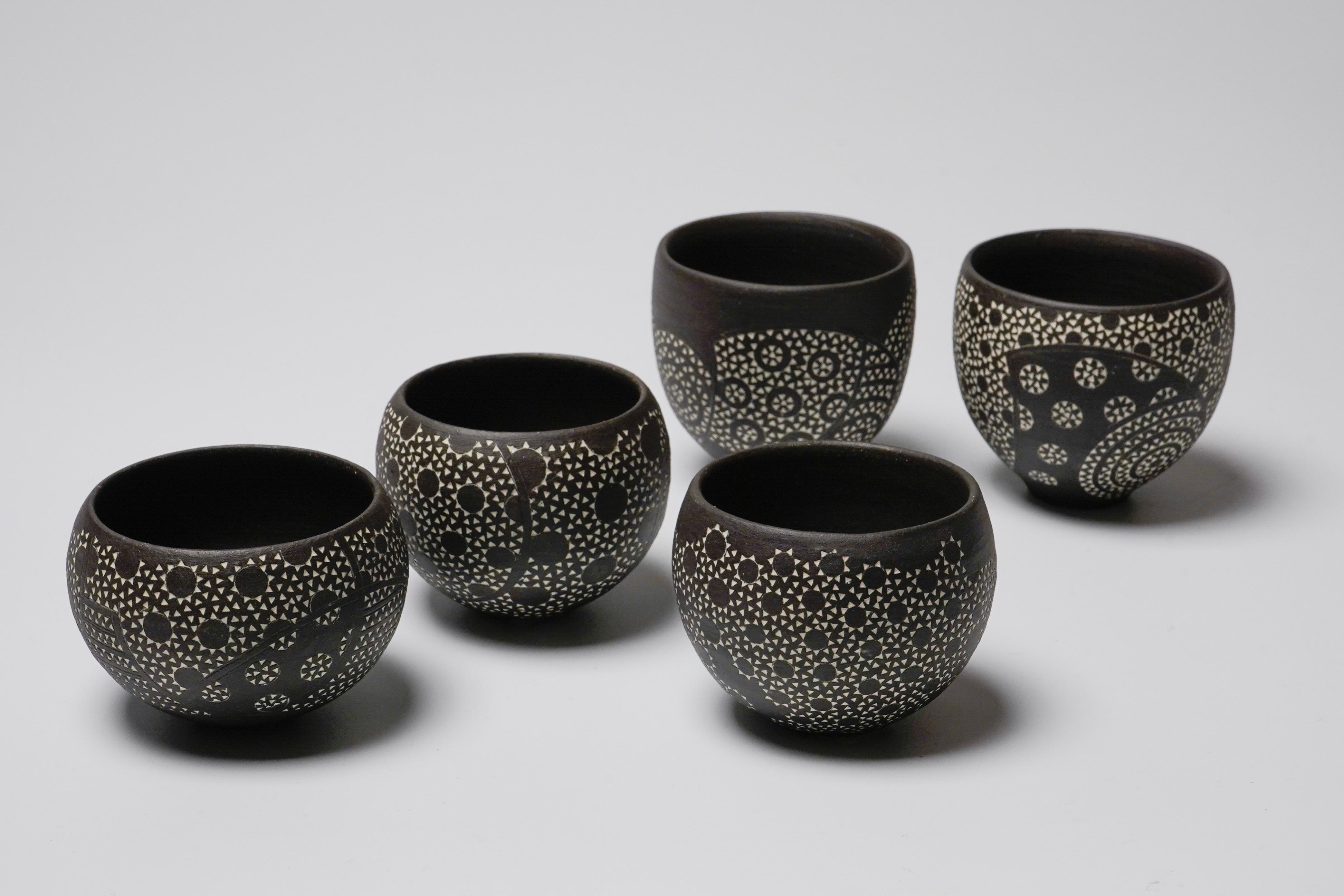

Kitamura Junko 北村 純子 (b. 1956)
Guinomi No. 1
With Signed Wood Box
Stoneware; (diameter) 2 5" x (h) 2"

With
(h) 2"
With
Stoneware; (diameter) 2.4" x (h) 2.4"
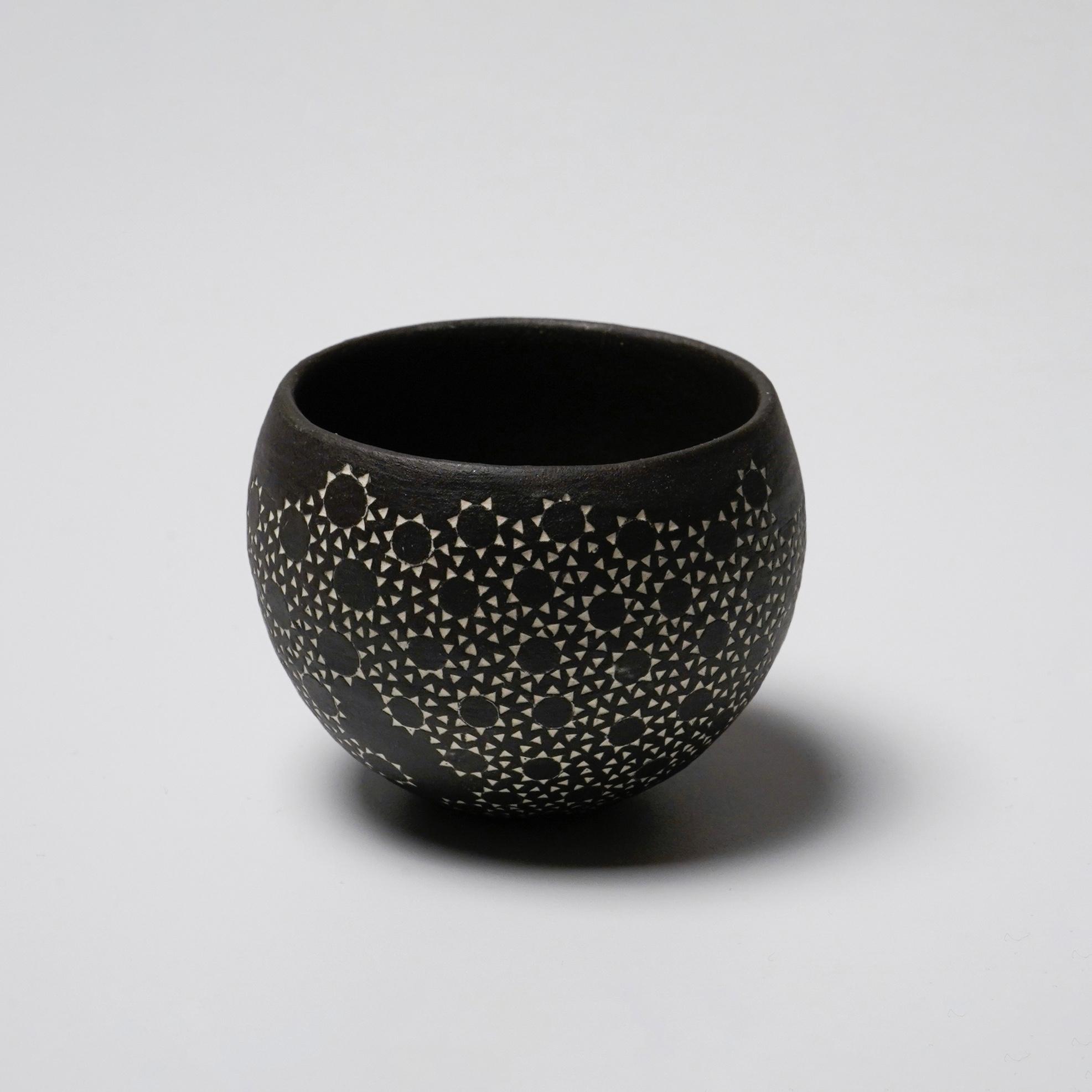


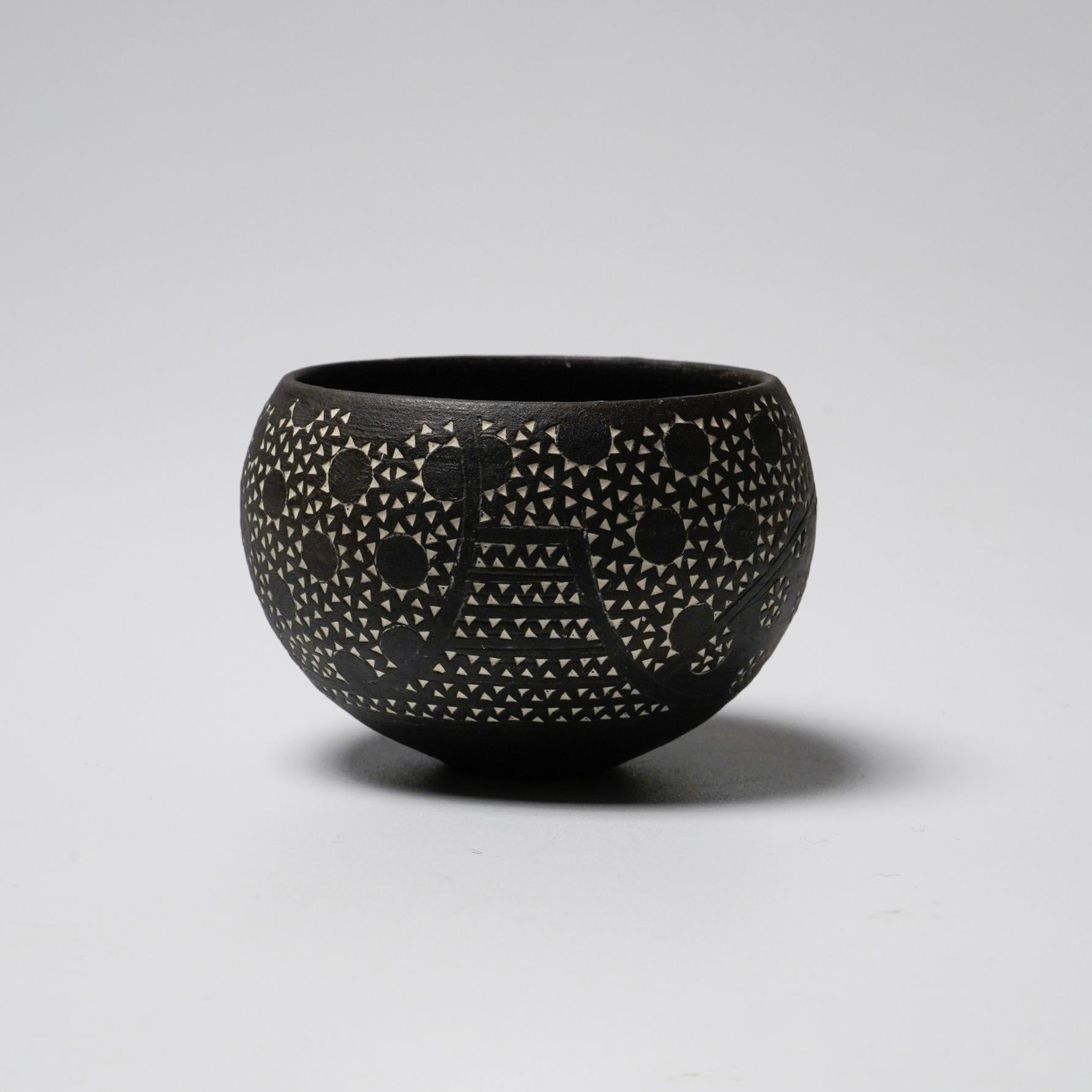 Guinomi No 4
Signed Wood Box
Guinomi No 5
With Signed Wood Box Stoneware; (diameter) 2.6" x (h) 2.3"
Guinomi No 3
Signed Wood Box Stoneware; (diameter) 2.6" x
Guinomi No 2
With Signed Wood Box Stoneware; (diameter) 2.6" x (h) 2"
Guinomi No 4
Signed Wood Box
Guinomi No 5
With Signed Wood Box Stoneware; (diameter) 2.6" x (h) 2.3"
Guinomi No 3
Signed Wood Box Stoneware; (diameter) 2.6" x
Guinomi No 2
With Signed Wood Box Stoneware; (diameter) 2.6" x (h) 2"


Kitamura Junko 北村 純子 (b. 1956)
Small Container with Lacquer Lid, No. 2 盒子
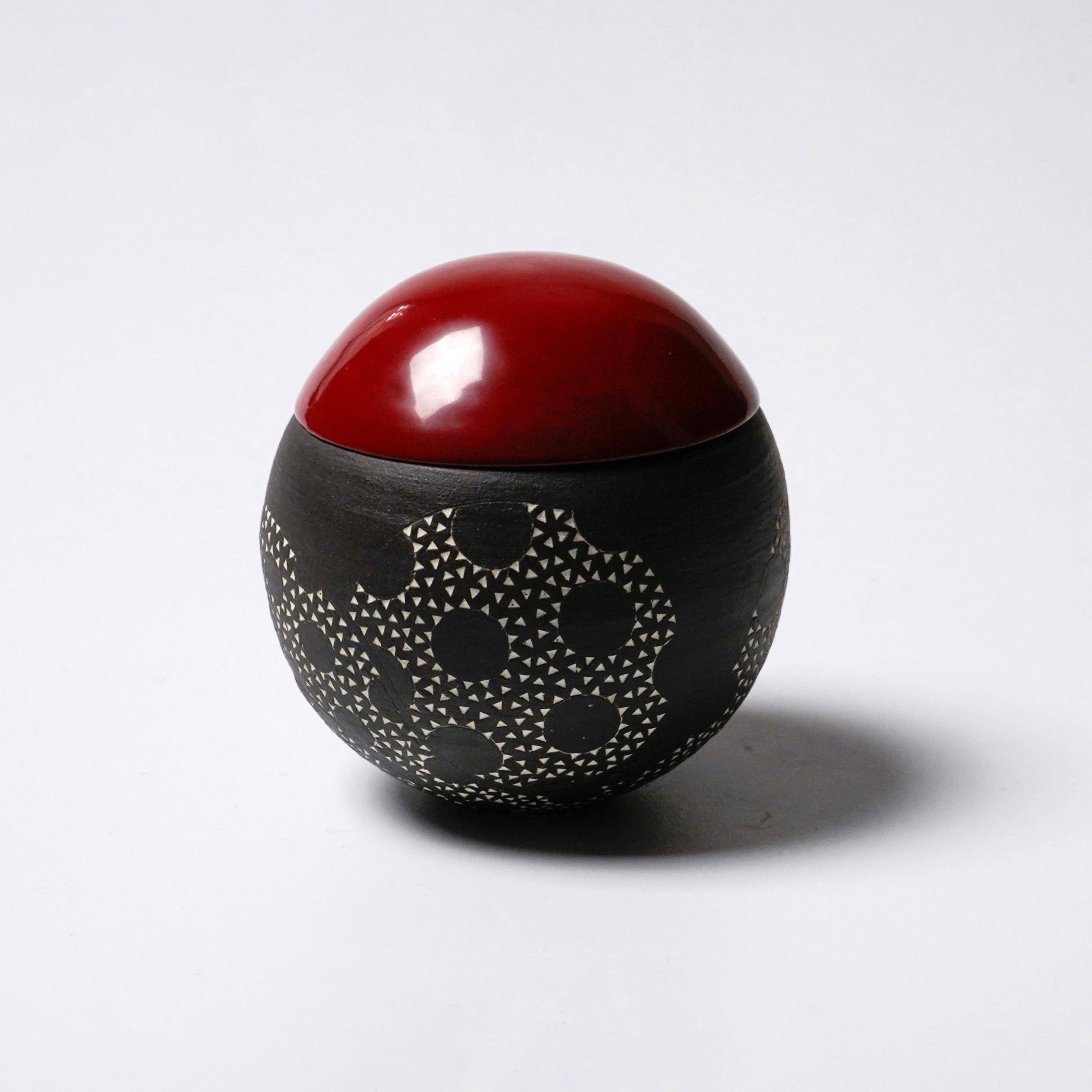
With Signed Wood Box
Stoneware, Lacquer; (diameter) 2.5" x (h) 2.7"
 Kitamura Junko 北村 純子 (b. 1956)
Small Container with Lacquer Lid, No. 1 盒子
With Signed Wood Box Stoneware, Lacquer; (diameter) 2.5" x (h) 2.8"
Kitamura Junko 北村 純子 (b. 1956)
Small Container with Lacquer Lid, No. 1 盒子
With Signed Wood Box Stoneware, Lacquer; (diameter) 2.5" x (h) 2.8"


Kitamura Junko 北村 純子 (b. 1956)
Small Container with Lacquer Lid, No. 3 盒子

With Signed Wood Box
Stoneware, Lacquer; (diameter) 2.5" x (h) 2.7"
 Kitamura Junko 北村 純子 (b. 1956)
Small Container with Natural Persimmon Wood Lid, No. 4 盒子 Stoneware, Natural Persimmon Wood; With Signed Wood Box (diameter) 2.6" x (h) 2.6"
Kitamura Junko 北村 純子 (b. 1956)
Small Container with Natural Persimmon Wood Lid, No. 4 盒子 Stoneware, Natural Persimmon Wood; With Signed Wood Box (diameter) 2.6" x (h) 2.6"

A N A K A Y U
Born in Ehime, The contemporary sculptor Tanaka Yu is known for her material invocations through the ceramic medium In particular, her works appear to be soft, malleable: her forms imitate the image of a colorful wrapped Furoshiki (Japanese wrapping cloth), over functional vessels. Precisely by invoking an image that covers up the utility aspect of everyday objects, her works question the line between object and vessel; form and function.
Her works are playful, coaxing the viewer to consider what her sculpted Furoshiki might contain Vague silhouettes of bowls, boxes, plates and cups can be found when examining the forms of her sculptures The viewer might spot an edge that reminds them of the lip of a vase, or the corner of a container. These ambiguous shapes are always framed by her signature knot, usually sat at an angle on the object. Tanaka’s clay is sourced from Shigaraki and elsewhere. Her mixed clay offers both porosity and plasticity. Her works are celebrated both within Japan and internationally, having been exhibited in several institutions and museums, garnering a significant accolade for what might be considered a young artist within the Japanese ceramic industry
⽥ 中 悠 T
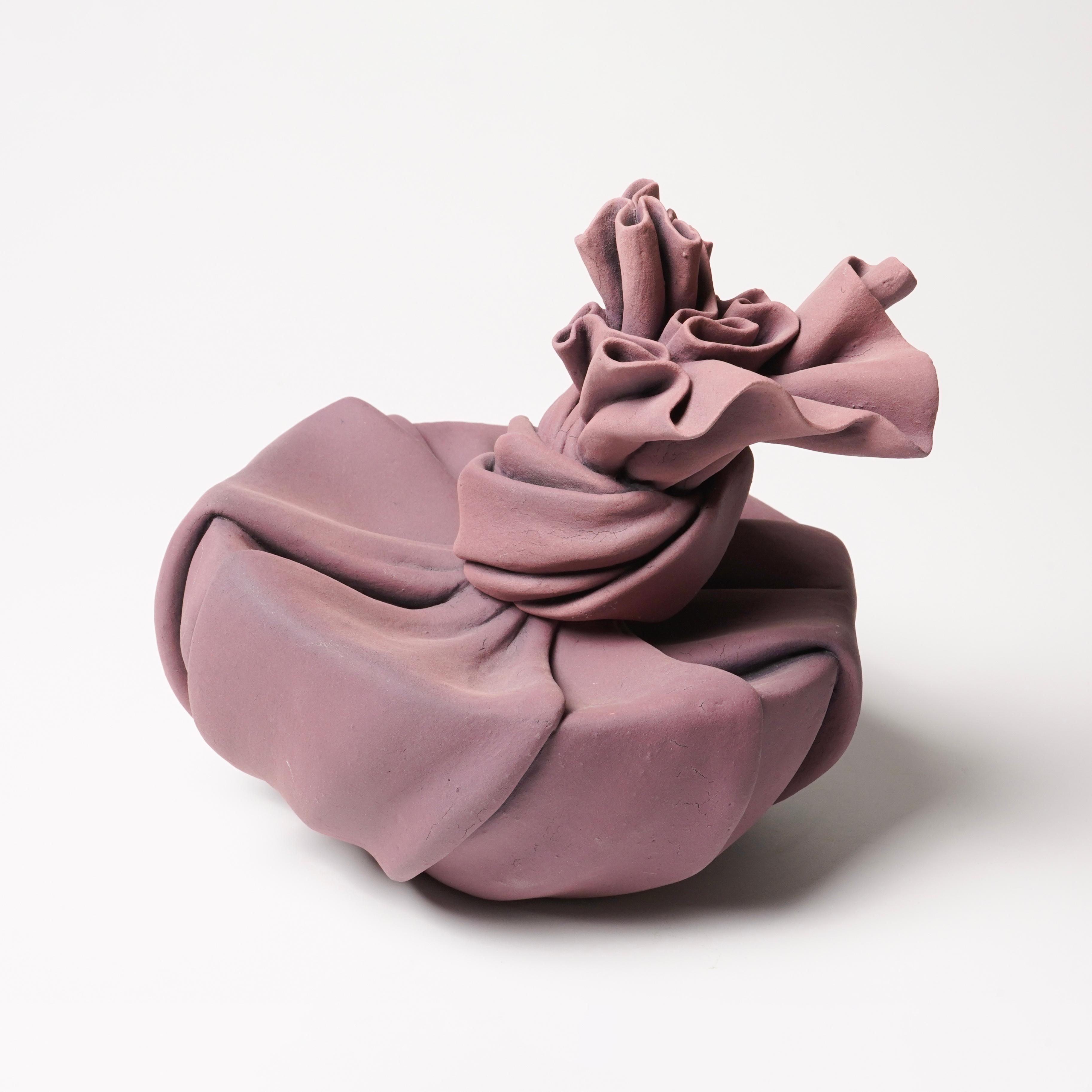
 Tanaka Yu 田中 悠 (b. 1989) Tsutsumimono
With Signed Wood Box Stoneware; (h) 6.5" x (w) 7.5" x (d) 6"
Tanaka Yu 田中 悠 (b. 1989) Tsutsumimono
With Signed Wood Box Stoneware; (h) 6.5" x (w) 7.5" x (d) 6"

Back in the 1980s, Nara-born Kishi Eiko began to create colored charmottes in Shigaraki clay. She then inlaid these into hand-built ceramic forms of breathtakingly precise shape.
Once fired, she reveals the chamottes through a careful process of hand picking and engraving a web of fine lines into the surface. One piece of chamotte is roughly 2mm, and when glazed shines like silk thread Kishi calls this Saishiki-Zogan 「
As this complicated technique became the signature of her sculptural voice, Kishi began to be recognized and has received many awards throughout the years, including Grand Prize at the Asahi Ceramics Exhibition in 1985, Silver Medal at the 51st International Competition for Contemporary Ceramic Art in Faenza, Italy in 1999, and the Education Ministry Prize from the Kyoto Prefectural Center for Arts & Culture in 2013 And she didn't stop there She feels that all great art springs from deep thinking and considered ideology, and felt that her own work needed more depth. So she returned to university in her late 40s to study humanities, and after graduation began to show her ceramics internationally.
彩⽯象嵌」
岸 映 ⼦ K
I S H I E I K O

With
Wood

映子
Kishi Eiko 岸
(b. 1948) Flower Vessel 彩石象嵌花
(d) 3" x (w) 9" x (h) 9.5"
Signed
Box Stoneware with coloured chamotte and glaze
I R U M A K A Z U Y O
Hiruma Kazuyo (b.1947) began her artistic career in 1976, when she worked under the guidance of ceramic artists Sugaki and Hisano Mizuno in Osaka. Prior to committing to her ceramic practice, Sakai City-born Hiruma had worked as a graphic designer for a decade. Hiruma founded her own kiln in 1988, and her ceramic work exploring natural phenomena has since exhibited and received awards internationally.
Her ceramic sculptures depicting water and earth inspire nuanced explorations of how these two natural forces interact with time.
Her works presented are fastidiously constructed yet remain anchored in natural phenomena. Hiruma layers thin sheets of clay horizontally or vertically to create each work, finally glazing and firing the ceramic after spending a month or two building it The artist’s practice stands out from contemporary ceramic work bound in tradition through its play with both space and movement. Dynamic and impressive in size, Hiruma’s work diverges from the smaller objects usually on display in a Japanese "tokonoma, or reception room.
昼 ⾺ 和 代
H
 Hiruma Kazuyo 昼馬 和代 (b. 1947)
Aflojar ゆるぐ, 2017
Stoneware; (h) 18 8" x (w) 22 4" x (d) 15 7"
Hiruma Kazuyo 昼馬 和代 (b. 1947)
Aflojar ゆるぐ, 2017
Stoneware; (h) 18 8" x (w) 22 4" x (d) 15 7"

The potter, artist, and sculptor Matsuda Yuriko turns towards whimsical depictions of everyday objects to create new perspectives Matsuda connects with her Japanese roots through a unique take on the perennial and iconic Japanese theme of the view of Mount Fuji. Born in 1943, her whimsical and contemporary interpretation of the iconic mountain, Fuji, is shrouded in seasonal change.
On one face, she paints a spring scene, with a river connecting between a grove of cherry blossoms and a lush, green, summer sequence. The mountain’s body is gilded in gold, accenting the symbolic shape of the mountain With these works, she has brought painting into three-dimensions, creating hybrid ceramic paintings that are entirely unique Like a traditional scroll, she generously accents her work with gold backgrounds, lending them an inherent inner glow. Her use of familiar subjects has a transformative effect: though we know that this is Mount Fuji, it is unlike any depiction of the scene we have ever experienced. This strange quality pulls the viewer into the piece, demanding further investigation.
Matsuda has been named one of the best 150 artists working in Japan by a noted ceramic arts publishing company for her deeply original work that celebrates an essential zest for the landscape of everyday life.
松 ⽥ 百 合 ⼦
M A T S U D A Y U R I K O
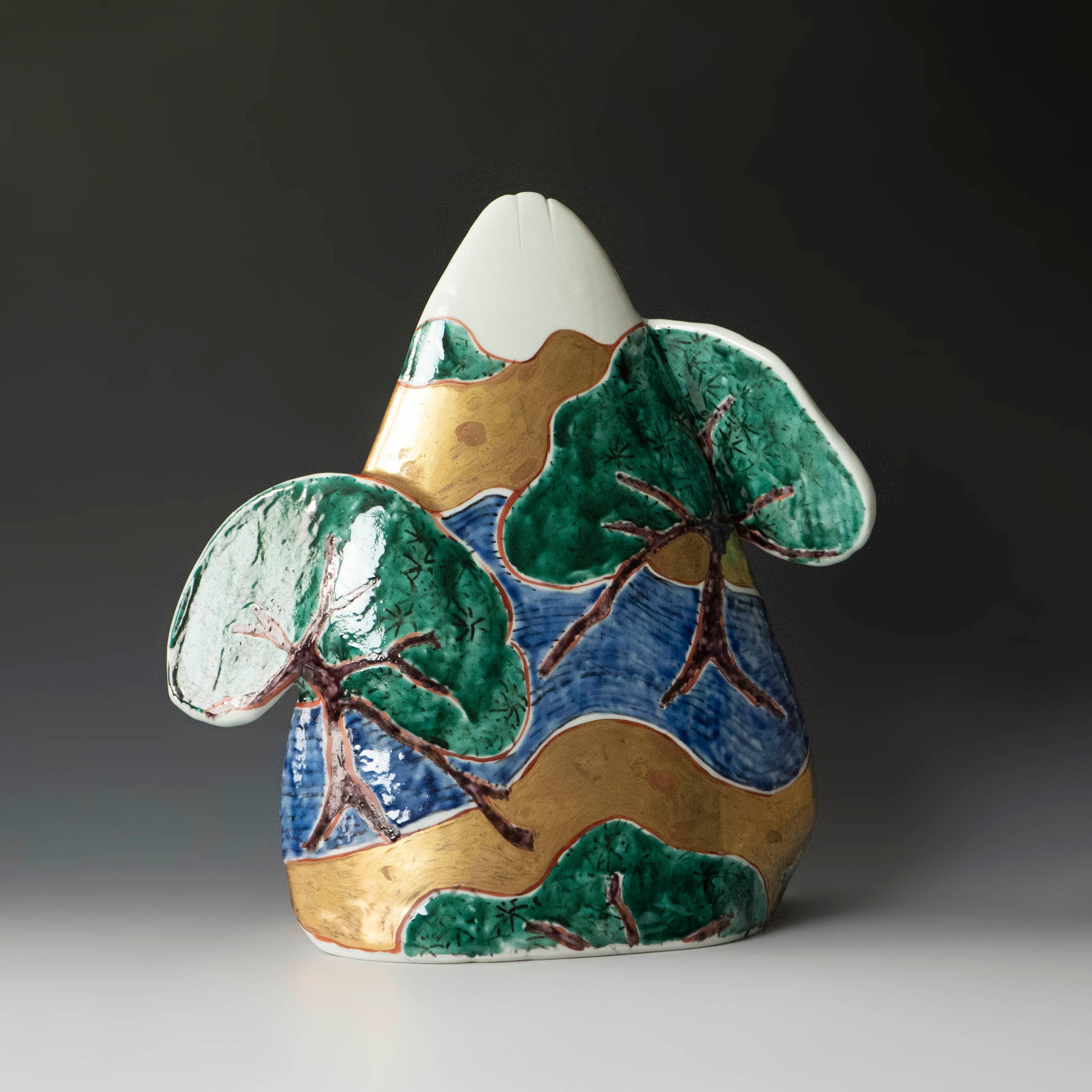
 Matsuda Yuriko 松田 百合子 (b. 1943) Mt.Fuji 不二さん, 2022
With Signed Wood Box; Enamel Glazed Porcelain (h) 16.9" x (w) 16.5" x (d) 6.2"
Matsuda Yuriko 松田 百合子 (b. 1943) Mt.Fuji 不二さん, 2022
With Signed Wood Box; Enamel Glazed Porcelain (h) 16.9" x (w) 16.5" x (d) 6.2"
Matsuda Yuriko 松田百合子 (b. 1943)
Flower Vessel 花器
With signed wood box; Enamel Glazed Porcelain
(h) 9.9" x (w) 6" x (d) 5.9"

 Matsuda Yuriko 松田 百合子 (b. 1943)
Water Pitcher 水注
With Signed Wood Box; Enamel Glazed Porcelain (h) 6.0" x (w) 9.6" x (d) 7.0"
Matsuda Yuriko 松田 百合子 (b. 1943)
Water Pitcher 水注
With Signed Wood Box; Enamel Glazed Porcelain (h) 6.0" x (w) 9.6" x (d) 7.0"

With
Matsuda Yuriko 松田 百合子 (b. 1943)
In her Shoes 2, 2008
 Signed Wood Box; Enamel Glazed Porcelain (h) 6.5” x (w) 10.5” x (d) 3”
Signed Wood Box; Enamel Glazed Porcelain (h) 6.5” x (w) 10.5” x (d) 3”

"The subject of my work is “decoration”. I understand “decoration” enables me to express indescribably complicated emotions and it is indispensable to human beings. At the same time that I entrust my own complicated emotions to “decoration”. Moreover, I am conscious of the existence of a kind of “order” in the “decoration” with this unique worldview I think it is the same as the order existing in the ebb and flow, breathing and pulse. I suppose I can also call it “rhythm”. I believe my works will resonate in everyone ’ s heart regardless of religion by cherishing this primordial “order”.
In the process of creating ceramics I experience the micro world touching the clay particles with fingers and the macro world by gravity from the glaze flow discovered through firing Accepting, taking advantage of this experience and creating the works I only can do, I will see the primordial “order” just like breathing or ebb and flow embodied in my works. Moreover this order will sublimate the emotional expression of "decoration" into more essential and higher sympathy with viewers. I sincerely hope that my “decoration” will provide a good chance for people present at my exhibition to sympathize with each other, transcending the differences of language, race, or religion."
In her artistic practice, Oishi Sayaka explores the possibilities of decoration, and how it offers philosophical, emotional and metaphorical potential in artistic expression in clay. She is an emerging artist whose works are exhibited domestically in Japan and abroad. She studied Maiolica techniques in Italy, melding historical techniques from abroad with Japanese sensibilities.
⼤ ⽯ 早 ⽮ ⾹ O I
S H I S A Y A K A


Oishi Sayaka 大石さやか (b. 1980) Sensitive Apple - New EraWith Signed Wood Box (h) 8.5" x (w) 7" x (d) 7"


Sayaka 大石早矢香 Sensitive Apple - Black & White, 2022 Exhibited at Kalamazoo Institute of Arts in 2023; Stoneware (h) 9.0" x (w) 7.8" x (d) 7.4"
Oishi
Oishi Sayaka 大石さやか (b. 1980)
Group of sake cups "Rabbit", 2023
With Signed Wood Box
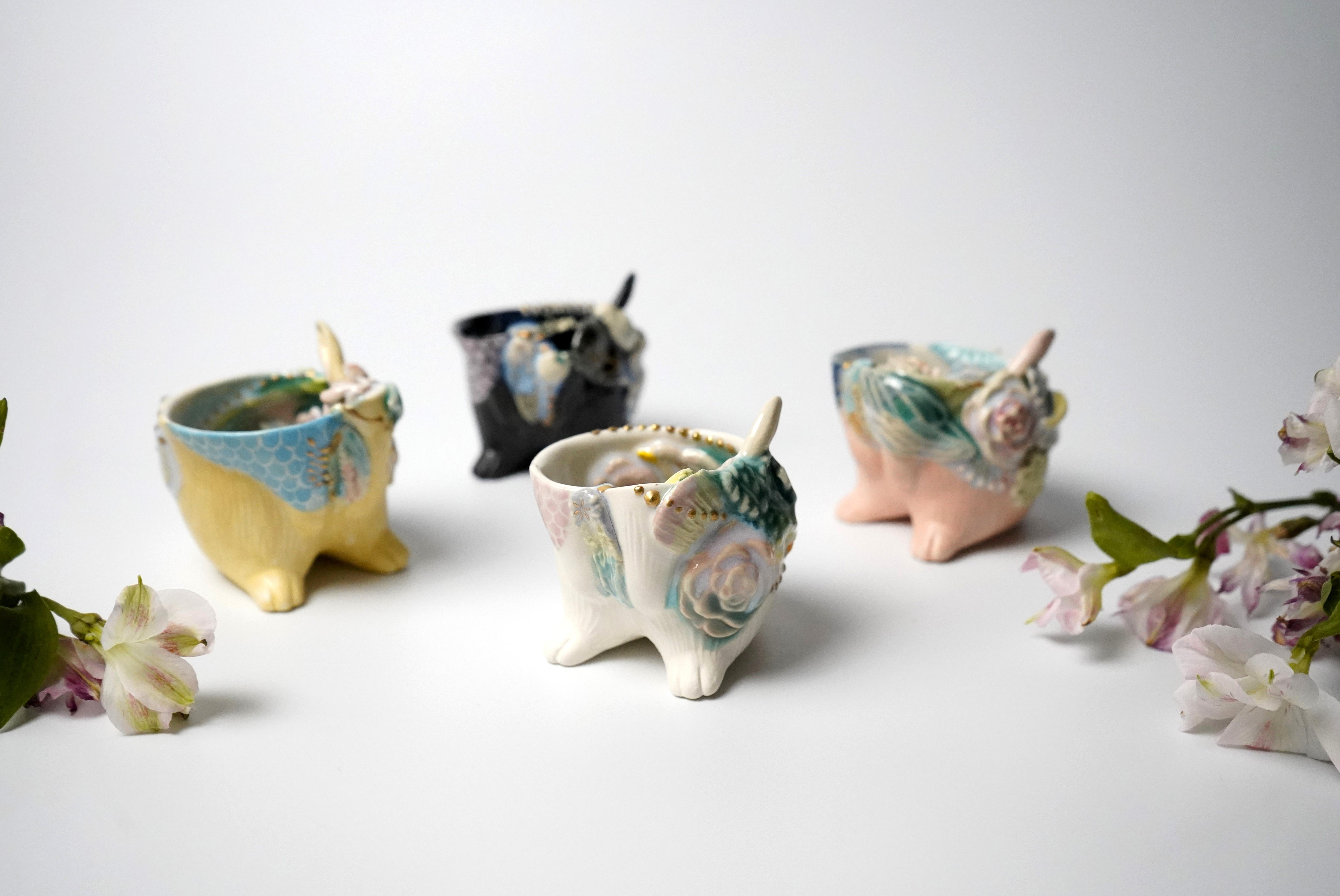


Born in Osaka and graduated from Osaka University of Arts, Tashima Etsuko’s sculptures bring together two historical craft mediums: glass casting and ceramic sculpture with a yellow oribe underglaze to create forms that enquire into the relationship between light, shadow, and color; Light permeates through materials and is altered, and expresses color by reflecting off surfaces She examines opacity and translucency through materiality
Having studied under Yanagihara Mutsuo (b 1934), her yellow glazes follow the bold colors that stem from the influence of American expressionism in the 70s, as well as his famous yellow Oribe glaze.
Tashima’s sculptural forms are streamlined, such as the pieces shown in this exhibition from her Cornucopia series The glass is casted after the shape of insects’ wings, while the vivid yellow, opaque, biomorphic body has a slight upwards curvature The name cornucopia recalls concepts of natural abundance. One imagines looking through a magnifying glass to examine the body of a smaller creature when gazing upon her pieces. As the first tenured female faculty member of the Osaka University of Arts, Tashima is part of a vanguard generation of highly influential post-war female artists in Japan whose practices are inspired by concepts of female sexuality and representations of nature.
⽥ 嶋 悦 ⼦ T
E T
O
A S H I M A
S U K
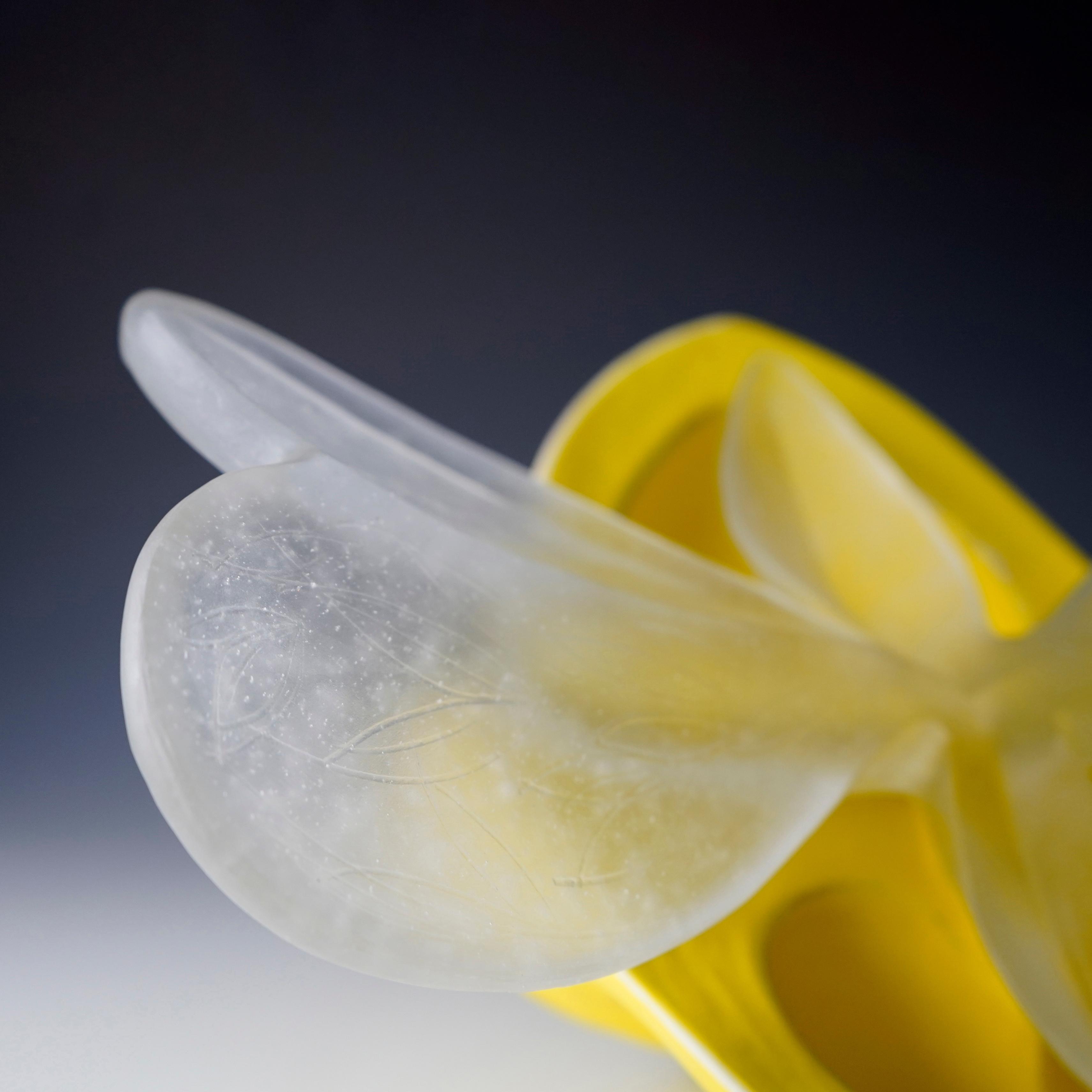

Cornucopia 09-Y12,
Stoneware,
(h) 8.6" x (w) 16.5" x (d) 14.1"
Tashima Etsuko 田嶋 悦子 (b. 1959)
2009
Glass


Tashima Etsuko 田嶋 悦子 (b. 1959) Cornucopia 09-Y9, 2009 Stoneware, Glass (h) 10.2" x (w) 19.6" x (d) 13.3"

H I N G U S A Y A K A
わが⾝世にふるながめせしまに
The flowers withered Their color faded away While meaninglessly I spent my days in the world And the long rains were falling
Born in Osaka in 1979, Shingu Sayaka is a contemporary ceramic artist based in Osaka, Japan. She is well-known in and outside Japan for her ceramic flower sculptures, though she creates both functional and sculptural works. Her pieces feature monochromatic mixed clay with slip and glaze Shingu takes on floral motifs as a metaphor for impermanence, ephemerality, and fleeting beauty Flowers are an ever lasting theme for artists, most notable in the west are the works of Robert Mapplethorpe and Georgia O'Keeffe to name a few.
In Japan, 無常 (Mujyo/ mutability, uncertainty, impermanence) is one of common sense. People loves 桜(Sakura/ Cherry blossoms) because it lasts not too long. Many arts have been made for that fleeting beauty One of the six best waka poets of the early Heian period, Ono no Komachi (⼩野⼩町 825-900), who was renowned for her unusual beauty, wrote the above poem about the flower and its fleeting beauty.
⼤ ⽯ 早 ⽮ ⾹ S
花の⾊はうつりにけりないたづらに

 Shingu Sayaka 新宮さやか (b. 1979) No. 20 Pitcher, 2022
With Signed Wood Box; Mixed Clay with Glaze and Slip (h) 5.5"x (w) 6 " x (d) 3.1"
Shingu Sayaka 新宮さやか (b. 1979) No. 20 Pitcher, 2022
With Signed Wood Box; Mixed Clay with Glaze and Slip (h) 5.5"x (w) 6 " x (d) 3.1"
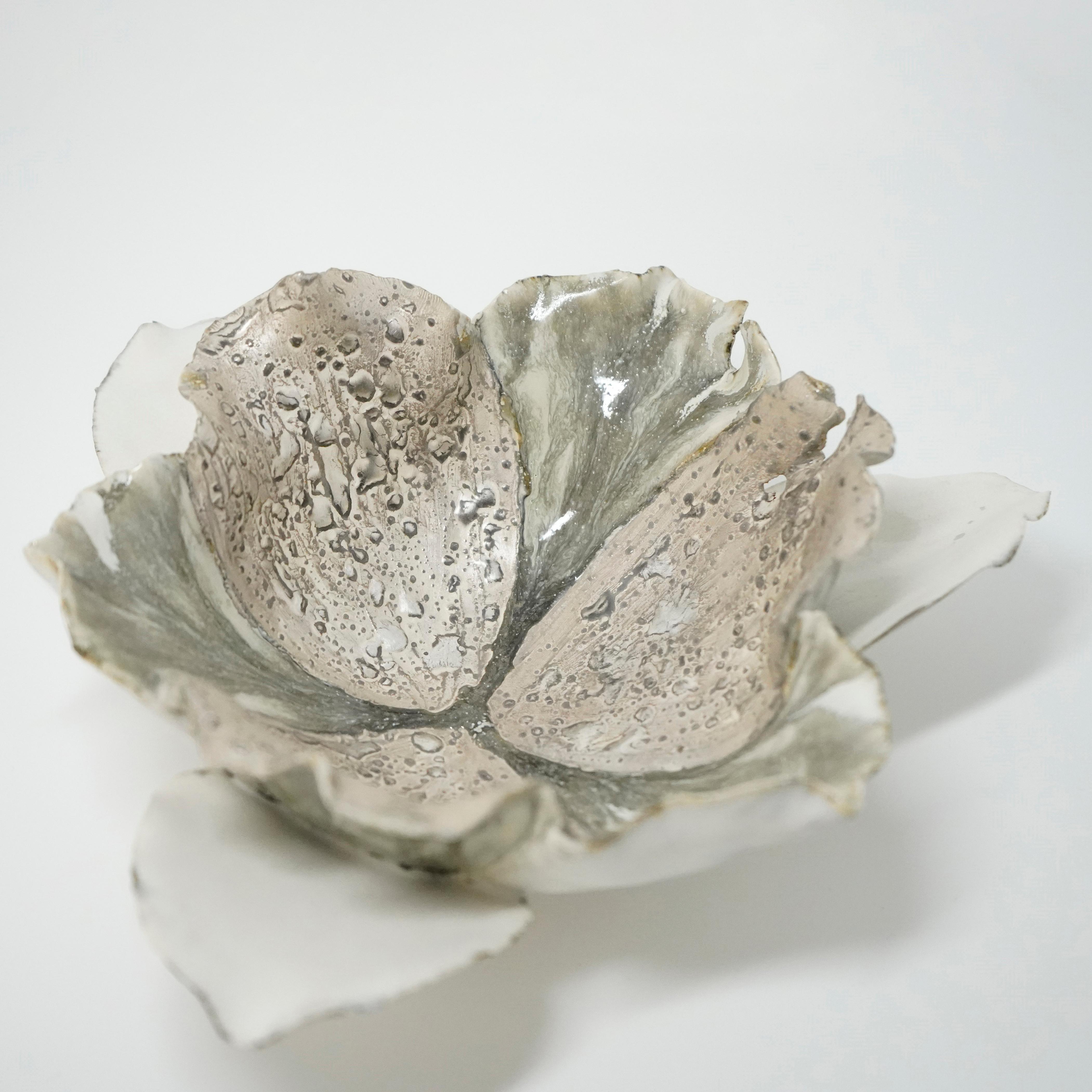

Shingu Sayaka 新宮さやか (b. 1979) No. 14 Padoma , 2022 With Signed Wood Box; Mixed Clay with Glaze Slip (h) 3.2"x (w) 8"x (d) 7"
Shingu Sayaka 新宮さやか (b. 1979)
No. 17 Erosion, 2022
With Signed Wood Box; Mixed Clay with Glaze and Slip
(h) 4.3"x (w) 8"x (d) 5.5"

 Shingu Sayaka 新宮さやか (b. 1979) No. 18 Erosion, 2022
With Signed Wood Box; Mixed Clay with Glaze and Slip (h) 4.3"x (w) 6.5"x (d) 5.9"
Shingu Sayaka 新宮さやか (b. 1979) No. 18 Erosion, 2022
With Signed Wood Box; Mixed Clay with Glaze and Slip (h) 4.3"x (w) 6.5"x (d) 5.9"


Shingu Sayaka 新宮さやか (b. 1979)
Group of sake cups, 2023 With Signed Wood Box; Mixed Clay with Glaze and Slip
G A W A M A C H I K O
Born in Sapporo in 1946, Ogawa Machiko studied Crafts at the Tokyo National University of Fine Arts and Music. As the first woman admitted to the prestigious ceramic department, Ogawa is a pioneer in her field. She is inspired by the natural beauty of the earth and the seaside. Her work meditates upon grand ideas that span beyond the human lifetime: materiality, our anthropocene, deep earth. Her works take on naturalistic textures of rocks, boulders, and cliffsides, evoking an elemental character too She examines the character of clay, considering the microscopic minerals and crystals that constitutes her fired stoneware. The object’s core materials guide her artistic process, embracing imperfection and allowing the natural formation of clay to reveal itself to her.
Ogawa’s technical prowess shines in her elegant forms that span both sculptural and functional She currently works in Kanagawa, Japan
⼩ 川 待 ⼦ O
Ogawa Machiko 小川 待子 (b. 1946) "Spring Haze" Tea bowl 春霞
With Signed Wood Box; Stoneware (diameter) 5.5"x (h) 3.5"

Osaka-born and Iga-based Watanabe Aiko (b. 1971) is a star in the Shigaraki ceramic industry. She is one of the few women potters working in Iga and Shigaraki pottery, committed to perfecting the art and forms of ash-glazed surfaces. Shigaraki and Iga’s unglazed stoneware surfaces witnessed a golden age in domestic tastes during the Momoyama period (1573-1603), and is now experiencing a revival in popularity during the 21st century. She originally majored in painting at the Saga University of Art, but later encountered Anagama kilns and ash-fired work. She then decided to devote herself to the art of wood fired ceramics having already built three Anagama kilns in Iga.
Her ceramics are characterized by the naturalistic effects that result from Anagama wood firing Perhaps her experience in painting has also informed her ceramic work, for her ash glazed surfaces present dynamic compositions of ash, fire, and stone complimented by the classic vermillion tones of fired, unglazed Shigaraki clay. The ash falls on the side of the piece to create balanced scrolling surface scapes of violet, olive green, white, and red. Her work is full of Wabi Sabi and Shibui sensibilities. These surfaces are a result of oscillating rhythms of oxidation and reduction that emerge from constant stoking of the fire. Watanabe compares this alternating pattern with a type of deep breathing by fire
渡 辺 愛 ⼦ W
A T A N A B E A I K O
Watanabe Aiko 渡辺 愛子 (b. 1971)
Shigaraki Tea bowl 信楽茶碗
With Signed Wood Box; Stoneware (diameter) 5.2"x (h) 3.5"

© Dai Ichi Arts, Ltd., 2023

Authorship: Beatrice Chang, eds. Kristie Lui
Catalog production: Haruka Miyazaki, Yoriko Kuzumi
Editorial & Catalog design: Kristie Lui
Front cover & inside images: Oishi Sayaka
Back cover & inside images: Matsuda Yuriko

N E W Y O R K , N Y , 1 0 0 6 5 , U S A W W W D A I I C H I A R T S C O M 2 1 2 2 3 0 1 6 8 0 | 9 1 7 4 3 5 9 4 7 3






 Shigematsu Ayumi 重松 あゆみ (b. 1958) Yellow Jomon, 2018
Stoneware
(h) 12.7" x (w) 11.0" x (d) 10.4"
Shigematsu Ayumi 重松 あゆみ (b. 1958) Yellow Jomon, 2018
Stoneware
(h) 12.7" x (w) 11.0" x (d) 10.4"

 Shigematsu Ayumi 重松 あゆみ (b. 1958)
Jomon Spiral, 2015
Stoneware
(h) 14.5" x (w) 12.5" x (d) 13.9"
Shigematsu Ayumi 重松 あゆみ (b. 1958)
Jomon Spiral, 2015
Stoneware
(h) 14.5" x (w) 12.5" x (d) 13.9"


 Kitamura Junko 北村 純子 (b. 1956) Vessel, 2022
With Signed Wood Box; Stoneware (h) 13” x (diameter) 11.5”
Kitamura Junko 北村 純子 (b. 1956) Vessel, 2022
With Signed Wood Box; Stoneware (h) 13” x (diameter) 11.5”





 Guinomi No 4
Signed Wood Box
Guinomi No 5
With Signed Wood Box Stoneware; (diameter) 2.6" x (h) 2.3"
Guinomi No 3
Signed Wood Box Stoneware; (diameter) 2.6" x
Guinomi No 2
With Signed Wood Box Stoneware; (diameter) 2.6" x (h) 2"
Guinomi No 4
Signed Wood Box
Guinomi No 5
With Signed Wood Box Stoneware; (diameter) 2.6" x (h) 2.3"
Guinomi No 3
Signed Wood Box Stoneware; (diameter) 2.6" x
Guinomi No 2
With Signed Wood Box Stoneware; (diameter) 2.6" x (h) 2"


 Kitamura Junko 北村 純子 (b. 1956)
Small Container with Lacquer Lid, No. 1 盒子
With Signed Wood Box Stoneware, Lacquer; (diameter) 2.5" x (h) 2.8"
Kitamura Junko 北村 純子 (b. 1956)
Small Container with Lacquer Lid, No. 1 盒子
With Signed Wood Box Stoneware, Lacquer; (diameter) 2.5" x (h) 2.8"


 Kitamura Junko 北村 純子 (b. 1956)
Small Container with Natural Persimmon Wood Lid, No. 4 盒子 Stoneware, Natural Persimmon Wood; With Signed Wood Box (diameter) 2.6" x (h) 2.6"
Kitamura Junko 北村 純子 (b. 1956)
Small Container with Natural Persimmon Wood Lid, No. 4 盒子 Stoneware, Natural Persimmon Wood; With Signed Wood Box (diameter) 2.6" x (h) 2.6"


 Tanaka Yu 田中 悠 (b. 1989) Tsutsumimono
With Signed Wood Box Stoneware; (h) 6.5" x (w) 7.5" x (d) 6"
Tanaka Yu 田中 悠 (b. 1989) Tsutsumimono
With Signed Wood Box Stoneware; (h) 6.5" x (w) 7.5" x (d) 6"



 Hiruma Kazuyo 昼馬 和代 (b. 1947)
Aflojar ゆるぐ, 2017
Stoneware; (h) 18 8" x (w) 22 4" x (d) 15 7"
Hiruma Kazuyo 昼馬 和代 (b. 1947)
Aflojar ゆるぐ, 2017
Stoneware; (h) 18 8" x (w) 22 4" x (d) 15 7"


 Matsuda Yuriko 松田 百合子 (b. 1943) Mt.Fuji 不二さん, 2022
With Signed Wood Box; Enamel Glazed Porcelain (h) 16.9" x (w) 16.5" x (d) 6.2"
Matsuda Yuriko 松田 百合子 (b. 1943) Mt.Fuji 不二さん, 2022
With Signed Wood Box; Enamel Glazed Porcelain (h) 16.9" x (w) 16.5" x (d) 6.2"

 Matsuda Yuriko 松田 百合子 (b. 1943)
Water Pitcher 水注
With Signed Wood Box; Enamel Glazed Porcelain (h) 6.0" x (w) 9.6" x (d) 7.0"
Matsuda Yuriko 松田 百合子 (b. 1943)
Water Pitcher 水注
With Signed Wood Box; Enamel Glazed Porcelain (h) 6.0" x (w) 9.6" x (d) 7.0"

 Signed Wood Box; Enamel Glazed Porcelain (h) 6.5” x (w) 10.5” x (d) 3”
Signed Wood Box; Enamel Glazed Porcelain (h) 6.5” x (w) 10.5” x (d) 3”












 Shingu Sayaka 新宮さやか (b. 1979) No. 20 Pitcher, 2022
With Signed Wood Box; Mixed Clay with Glaze and Slip (h) 5.5"x (w) 6 " x (d) 3.1"
Shingu Sayaka 新宮さやか (b. 1979) No. 20 Pitcher, 2022
With Signed Wood Box; Mixed Clay with Glaze and Slip (h) 5.5"x (w) 6 " x (d) 3.1"



 Shingu Sayaka 新宮さやか (b. 1979) No. 18 Erosion, 2022
With Signed Wood Box; Mixed Clay with Glaze and Slip (h) 4.3"x (w) 6.5"x (d) 5.9"
Shingu Sayaka 新宮さやか (b. 1979) No. 18 Erosion, 2022
With Signed Wood Box; Mixed Clay with Glaze and Slip (h) 4.3"x (w) 6.5"x (d) 5.9"















